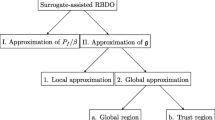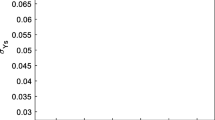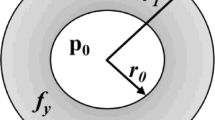Abstract
In this paper, we proposed a two-stage hybrid reliability analysis framework based on the surrogate model, which combines the first-order reliability method and Monte Carlo simulation with a doubly-weighted moving least squares (DWMLS) method. The first stage consists of constructing a surrogate model based on DWMLS. The weight system of DWMLS considers not only the normal weight factor of moving least squares, but also the distance from the most probable failure point (MPFP), which accounts for reliability problems. An adaptive experimental design scheme is proposed, during which the MPFP is progressively updated. The approximate values and sensitivity information of DWMLS are chosen to determine the number and location of the experimental design points in the next iteration, until a convergence criterion is satisfied. In the second stage, MCS on the surrogate model is then used to calculate the probability of failure. The proposed method is applied to five benchmark examples to validate its accuracy and efficiency. Results show that the proposed surrogate model with DWMLS can estimate the failure probability accurately, while requiring fewer original model simulations.








Similar content being viewed by others
Abbreviations
- n :
-
number of input random variables
- N:
-
number of experimental points
- x :
-
vector of input random variables
- β :
-
reliability index
- β HL :
-
reliability index by Hasofer–Lind algorithm
- μ :
-
mean
- σ :
-
standard deviation
- g(X):
-
limit state function
- \(\hat{{g}}({\rm {\bf X}})\) :
-
approximate limit state function/ response surface function
- X add :
-
new added experimental points in any iteration
- MLS:
-
moving least square
- DWMLS:
-
doubly weighted moving least square
- SVR:
-
support vector regression
- ANN:
-
artificial neural networks
- MPFP:
-
most probable failure point
- MCS:
-
Monte Carlo Simulation
- FORM:
-
first order reliability method
- SORM:
-
second order reliability method
- H–L:
-
Hasofer–Lind algorithm
- RSM:
-
response surface method
- LHD:
-
Latin hypercube design
- FEA:
-
finite element analysis
- CFD:
-
computational fluid dynamics
- COV:
-
coefficient of variation
- UDR:
-
Univariate Dimension-Reduction
- MPP-UDR:
-
Most probable point based UDR
- SGI:
-
Sparse Grid Interpolation
References
Bucher CG, Bourgund U (1990) A fast and efficient response surface approach for structural reliability problems. Struct Saf 7:57–66
Bucher C, Most T (2008) A comparison of approximate response functions in structural reliability analysis. Probab Eng Mech 23:154–163
Cheng J, Li Q, Xiao R (2008) A new artificial neural network based response surface method for structural reliability analysis. Probab Eng Mech 23:51–63
Choi SK, Grandhi R, Canfield R (2003) Reliability analysis of a large computational model using polynomial chaos expansion. In: SAE 2003 World Congress, Detroit, Michigan
Das P, Zheng Y (2000) Cumulative formation of response surface and its use in reliability analysis. Probab Eng Mech 15:309–15
Ditlevsen O, Madsen H (1996) Structural reliability methods. Wiley, Hoboken
Duprat F, Sellier A (2006) Probabilistic approach to corrosion risk due to carbonation via an adaptive response surface method. Probab Eng Mech 21:207–216
Echard B, Gayton N, Lemaire M (2011) AK-MCS: an active learning reliability method combining Kriging and Monte Carlo simulation. Struct Saf 33:145–154
Elhewy AH, Mesbahi E, Pu Y (2006) Reliability analysis of structures using neural network method. Probab Eng Mech 21:44–53
Faravelli L (1989) Response-surface approach for reliability analysis. J Eng Mech 115:2763–2781
Forrester A, Sobester A, Keane A (2008) Engineering design via surrogate modelling: a practical guide. Wiley, Chichester
Gomes HM, Awruch AM (2004) Comparison of response surface and neural network with other methods for structural reliability analysis. Struct Saf 26:49–67
Guan XL, Melchers RE (2001) Effect of response surface parameter variation on structural reliability estimates. Struct Saf 23:429–444
Guo Z, Bai G (2009) Application of least squares support vector machine for regression to reliability analysis. Chin J Aeronauti 22:160–166
Hurtado JE (2004) Structural reliability: statistical learning perspectives. Springer, Heidelberg
Hurtado JE, Alvarez DA (2001) Neural-network-based reliability analysis: a comparative study. Comput Methods Appl Mech Eng 191:113–132
Iman RL, Conover WJ (1980) Small sample sensitivity analysis techniques for computer models, with an application to risk assessment. Comm Stat Theor Meth 17:1749–1842
Jin R, Chen W, Sudjianto A (2005) An efficient algorithm for constructing optimal design of computer experiments. J Stat Plan Inference 134:268–287
Kang SC, Koh HM, Choo JF (2010) An efficient response surface method using moving least squares approximation for structural reliability analysis. Probab Eng Mech 25:365–371
Kaymaz I (2005) Application of Kriging method to structural reliability problems. Struct Saf 27:133–151
Kaymaz I, McMahon C (2005) A response surface method based on weighed regression for structural reliability analysis. Probab Eng Mech 20:11–17
Kim S, Na S (1997) Response surface method using vector projected sampling points. Struct Saf 19:3–19
Kim NH, Wang H, Queipo NV (2006) Adaptive reduction of random variables using global sensitivity in reliability-based optimisation. Int J Reliab Saf 1(1/2):102–115
Krishnamurthy T (2005) Comparison of response surface construction methods for derivative estimation using moving least squares, Kriging and Radial basis functions. In: 46th AIAA/ASME/ASCE/AHS/ASC Structures, Structural Dynamics & Materials Conference. Austin, Texas, pp 1–28
Lancaster P, Salkauskas K (1981) Surfaces generated by moving least squares methods. Math Comp 37:141–158
Liu Y, Moses F (1994) A sequential response surface method and its application in the reliability analysis of aircraft structural system. Struct Saf 16(1–2):39–46
McKay MD, Bechman RJ, Conover WJ (1979) A comparison of three methods for selecting values of input variables from a computer code. Technometrics 21:239–245
Most T (2007) An adaptive response surface approach for structural reliability analyses based on support vector machines. Proceedings of the Eleventh International Conference on Civil, Structural and Environmental Engineering Computing, B.H.V. Topping
Nguyen XS, Sellier A, Duprate F, Pons G (2009) Adaptive response surface method based on a double weighted regression technique. Probab Eng Mech 24:135–143
Panda SS, Manohar CS (2008) Applications of meta-models in finite element based reliability analysis of engineering structures. Comput Model Eng Sci 28:161–184
Papadrakakis M, Papadopoulos V, Lagaros ND (1996) Structural reliability analysis of elastic–plastic structures using neural networks and Monte Carlo simulation. Comput Methods Appl Mech Eng 136:145–163
Picheny V, Ginsbourger D, Roustant O, Haftka R, Kim N (2010) Adaptive designs of experiments for accurate approximation of a target region. J Mech Des 132(7):071008
Queipo N, Haftka RT, Shyy W, Goel T, Vaidyanathan R, Tucker P (2005) Surrogate-based analysis and optimization. Prog Aerosp Sci 41:1–28
Rahman S, Wei D (2006) A univariate approximation at most probable point for higher-order reliability analysis
Rachwitz R (2001) Reliability analysis-a review and some perspectives. Struct Saf 23:365–395
Rajashkhar M, Ellingwood B (1993) A new look at the response approach for reliability analysis. Struct Saf 12:205–220
Schueremans L, Gemert DV (2005) Benefit of splines and neural networks in simulation based structural reliability analysis. Struct Saf 27:246–261
Simpson TW, Poplinski JD, Koch PN, Allen JK (2001) Metamodels for computer based engineering design: survey and recommendations. Eng Comput 17:129–150
Song CY, Lee J, Choung JM (2011) Reliability-based design optimization of an FPSO riser support using moving least squares response surface meta-models. Ocean Eng 38:304–318
Viana FAC, Venter G, Balabanov V (2010a) An algorithm for fast optimal Latin hypercube design of experiments. Int J Numer Methods Eng 82(2):135–156
Viana FAC, Picheny V, Haftka RT (2010b) Using cross validation to design conservative surrogates. AIAA J 48(10):2286–2298
Viana FAC (2010) SURROGATES Toolbox User’s Guide, Version 2.1. http://sites.google.com/site/felipeacviana/surrogatestoolbox
Wei D, Rahman S (2007) Structural reliability analysis by univariate decomposition and numerical integration. Probab Eng Mech 22:27–38
Wong FS (1985) Slope reliability and response surface method. J Geotech Eng 111:32–53
Xiong FF, Greene S, Chen W, Xiong Y, Yang S (2010) A new sparse grid based method for uncertainty propagation. Struct Multidiscipl Optim 41:335–349
Youn BD, Choi KK (2004) A new response surface methodology for reliability-based design optimization. Comput Struct 82:241–256
Zadeh PM, Toropov VV, Wood AS (2005) Use of moving least squares method in collaborative optimization. In: 6th World Congresses of Structural and Multidisciplinary Optimization. Rio de Janeiro Brazil
Zou T, Mahadevan S, Mourelatos Z, Meernik P (2002) Reliability analysis of automotive body-door subsystem. Reliab Eng Syst Saf 78:315–324
Acknowledgments
The study reported in this paper was funded by China Scholarship Council under support number 2010623114. The authors also thank Prof. Raphael T. Haftka and Dr Felipe A. C. Viana for their valuable comments.
Author information
Authors and Affiliations
Corresponding author
Rights and permissions
About this article
Cite this article
Li, J., Wang, H. & Kim, N.H. Doubly weighted moving least squares and its application to structural reliability analysis. Struct Multidisc Optim 46, 69–82 (2012). https://doi.org/10.1007/s00158-011-0748-2
Received:
Revised:
Accepted:
Published:
Issue Date:
DOI: https://doi.org/10.1007/s00158-011-0748-2




